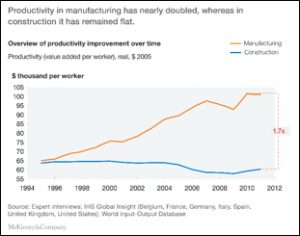
BIM drives productivity gains in construction sector
By David Bowcott
Risk Management BIM manufacturing productivity riskEveryone has seen the graphs that show construction on a downward productivity trend while other industries boast solid productivity gains. The following is a productivity graph that was produced by McKinsey & Co. that compares productivity in construction to that of the manufacturing sector from 1994 to 2011.
The graph illustrates productivity growth of the manufacturing sector is almost two times that of the construction sector. Graphics like this have fuelled a drive within the global construction industry to find ways to improve productivity. And, it appears to be working. Graphs being produced in 2017 are starting to show the construction productivity line trending upwards.
Before we dive into compiling a list of reasons as to why the construction sector is beginning to improve its productivity position, let’s discuss briefly what the reaction of the construction industry was when graphs like the one above came out, and how it started the industry on a track to reap similar improvements in productivity.
When the construction sector first started seeing productivity graphs like the one above, the immediate reaction was that they weren’t fair. Several top minds within the construction sector felt comparing manufacturing to construction was the ultimate comparison of apples to oranges. Manufacturing is done in a single location under a controlled environment, using well-organized sequencing strategies in order to optimize efficiency. Construction jobs are anything but a single location, and rarely take place in an antiseptic environment. Too many variables driven by the specific location of the construction project do not allow for the same elegant dance of machinery and people that one would see in a manufacturing plant. Ultimately, the manufacturing sector has the luxury of being able to see problems, or risks, much faster than the construction sector. The point made by the construction sector in response to these productivity graphs were well understood by all, and set construction experts on a path to try and figure out ways to turn the “snowflake” like nature of a construction project, into a manufacturing-like environment. These graphs led the construction sector to ask itself – How could it gain better visibility around things going wrong on their projects, to the same degree the manufacturing sector has such visibility?
The primary pillar that set the construction industry down a path to replicate the visibility on risk that manufacturing has, is Building Information Modeling or BIM. The Institute for BIM in Canada published a document in 2013 called Benefits of BIM for Owners whereby they defined BIM as follows:
“The term BIM refers to both a set of electronic models that describe a building as well as the collaborative process of using those models to plan, execute and manage the physical building itself. Virtually all BIM models contain the geometry of a building, including spaces and services, yet BIM is more than 3D CAD. In addition to geometry, models contain functional requirements, implementation details, and other information. For example, the BIM representation of a pump might include the physical dimensions, location within the building, installation notes, operating schedule, warranty and maintenance records, as well as links to other components in the system.”
BIM is a multi-dimensional mapping of what the physical asset should look like and through its implementation on the project all project stakeholders are given much greater visibility of how the asset should be constructed. It is the primary vehicle by which all parties involved in the project ensure things are done right. What’s more the wave of technology that is coming out and attaching itself to the BIM models (AR/VR, scanning technology, artificial intelligence, printable technologies, robotics, etc.) is allowing for even greater visibility into risks, thus making BIM a primary pillar in the drive to improve productivity within the construction sector. When you start to see that construction productivity line perking up towards the sky, know full well a majority of its change in direction can be attributed to the introduction and implementation of BIM models on construction projects.
 David Bowcott is Global Director – Growth, Innovation & Insight, Global Construction and Infrastructure Group at Aon Risk Solutions. Please send comments to editor@on-sitemag.com
David Bowcott is Global Director – Growth, Innovation & Insight, Global Construction and Infrastructure Group at Aon Risk Solutions. Please send comments to editor@on-sitemag.com





